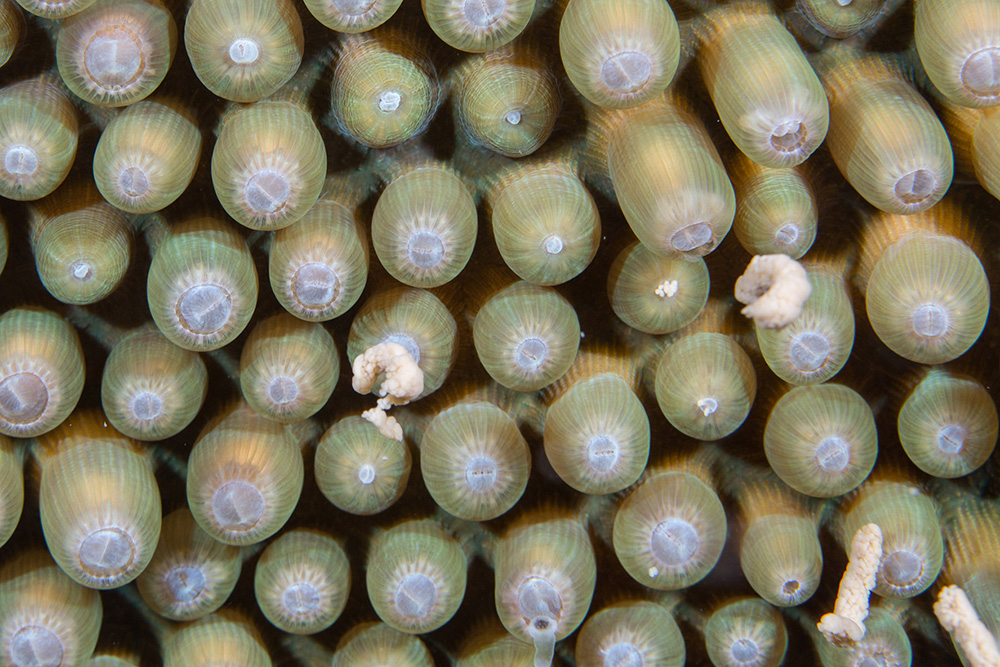
Every August, the reef-building corals of Flower Garden Banks National Marine Sanctuary put on a fantastic spawning display. It is one of the most abundant coral spawning displays in the entire Caribbean due to the high density cover of broadcast spawning species.
In ways that we still don't understand, each coral species times its gamete (egg and sperm) release for maximum benefit.

These mass spawning events are designed to allow genetic mixing and dispersal of offspring over large distances. The sheer volume of the events allows for the fertilization and survival of a significant number of larvae.
Timing
At the Flower Garden Banks, this event typically occurs 7-10 days after the full moon in August. However, when a full moon occurs in early August or late July, or if two full moons occur in August, mass spawning can happen in September instead of, or in addition to August.
The timing for these mass spawning events varies from reef to reef around the world.
Methods
Most broadcast spawners are hermaphroditic, meaning that both sexes are represented in each coral polyp. Hermaphroditic species release bundles that contain both egg and sperm (gametes). These bundles rise to the surface and break open, allowing for mixing and fertilization.

A few broadcast spawners are gonochoric, meaning that they have separate male and female colonies. In gonochoric species, female colonies release bundles that contain only eggs while male colonies release a smoky, white cloud of sperm. Egg bundles float toward the surface then break open to mix with the sperm for fertilization.

In both cases, floating gametes and gamete bundles create a sheen on the surface of the water and give off a distinctive odor.

The following species participate in the annual mass spawning event at FGBNMS.
Colpophyllia natans (Boulder Brain Coral)
Montastraea cavernosa* (Great Star Coral)
Orbicella annularis (Lobed Star Coral)
Orbicella faveolata (Mountainous Star Coral)
Orbicella franksi (Boulder Star Coral)
Pseudodiploria strigosa (Symmetrical Brain Coral)
Stephanocoenia intersepta* (Blushing Star Coral)
* gonochoric species.
Observations
Coral spawning at the Flower Garden Banks was first reported by divers on board the dive boat Fling, on August 13, 1990. Since then, sanctuary researchers have been documenting the mass coral spawning event to accumulate more precise data on timing and species participation.
A summary of these observations is available on our Spawning Observations page.
Video description: A male colony of Great Star Coral (Montastraea cavernosa) releasing smoky, white sperm followed by a close-up view of a female colony of Great Star Coral releasing egg bundles. This is followed by star and brain coral species releasing BB-like bundles of both egg and sperm in the following sequence: Mountainous Star Coral (Orbicella faveolata) with a red Serpent Brittle Star (Ophioderma squamosissimus) perched on top; Boulder Star Coral (Orbicella franksi); Boulder Star Coral with a Christmas Tree Worm (Spirobranchus giganteus); Mountainous Star Coral; close-up of a star coral (Orbicella sp.); Blushing Star Coral (Stephanocoenia intersepta); Symmetrical Brain Coral (Pseudodiploria strigosa); a Ruby Brittle Star (Ophioderma rubicundum) snaking its way across a colony of star coral with one arm wrapped around a bunch of egg bundles; egg bundles streaming off various colonies of star corals and rising through the water column; a diver disappearing into the darkness behind a "snowstorm" of egg bundles. (Video Length: 2:02; Credit: Emma Hickerson & G.P. Schmahl/FGBNMS)
Still Learning
Despite all the years of observation, we still haven't determined the exact cues for spawning to begin--although we're fairly certain that it is some combination of lunar cycle, solar cycle, water temperature, and chemical or light cues. Nor do we know how the corals coordinate their efforts so that multiple colonies of the same species are spawning at the same time.
Through continued research and observation we hope to find the answers.

